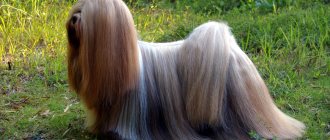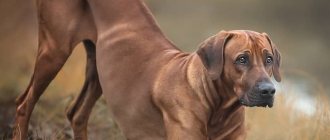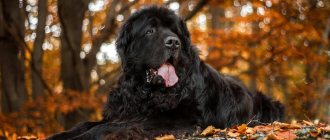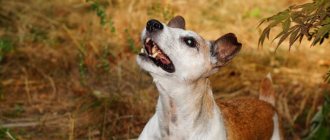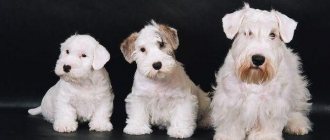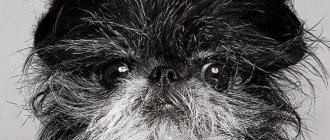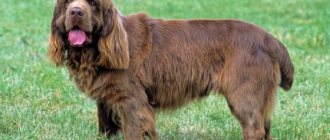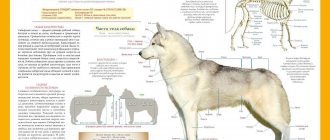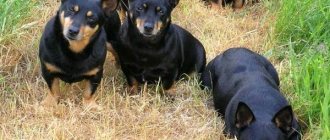Quick navigation
Characteristics and description of the breed
Height at withers: 25-28 cm,
Weight: 4-7 kg.
Acceptable color:
- sand;
- honey;
- gold;
- smoky;
- dark gray with gray streaks;
- black;
- party color;
- white;
- brown.
Additional characteristics: a small dog with long and thick hair that flows smoothly from the body to the surface of the floor.
The Apso has a well-balanced, strong body. The head is covered with voluminous hair that covers the eyes. The muzzle is straight, about 4 cm long, decorated with a rich mustache and beard. The ears droop and have long, thick hair, reminiscent of a woman's hairstyle with straight hair.
The eyes of the Lhasa Apso are dark in color, expressive, with long eyelashes. Please note that the white of the eye should not be visible from either the top or bottom of the eyeball.
The paws are straight, parallel to each other, overgrown, and the high-set tail looks like a “plume” due to the long hair hanging from it. The dog's movements are light and free.
Generally recognized breed standards
FCI breed standard No. 227/02/16/2011. Breed classification:
- country of origin: Tibet;
- patronage: UK;
- Application: companion dog;
- general impression: a small dog with thick, coarse and very long hair;
- behavior/temperament: cheerful and self-confident (assertive), vigilant, balanced, reserved towards strangers;
- classification of the International Association of Cynological Federations (ICF): group 9: decorative and companion dogs;
- section 5: Tibetan breeds;
- no operational tests.
Table: external features of the breed
| Options | Description |
| Head | Square, powerful, covered with beautiful thick hair that flows down and covers the eyes, but does not interfere with vision, with a long mustache and beard |
| Scull | Moderately narrow, the upper longitudinal line of the skull smoothly passes from the forehead to the occipital protuberance. The skull should not be domed or apple-shaped |
| Stop (transition from forehead to nose) | Moderate |
| Nose | The bridge of the nose is straight, the nose is black |
| Muzzle | Medium length, but not square, almost 4 cm long. Constitutes about 1/3 of the total length of the head |
| Jaws/teeth | The outer side of the upper incisors is in close contact with the inner side of the lower ones, that is, the bite is a “tight” overbite. The incisors are set wide and their line is as straight as possible. Complete dental formula is desirable |
| Eyes | Dark, almond-shaped, medium in size, straight set, not prominent or too deep set. The whites of the eyes should not be visible either at the base or at the top. |
| Ears | Hanging, covered with long hair |
| Neck | Strong and well curved |
| Frame |
|
| Tail | Set high, carried over the back, but not curled. There is often a loop at the end of the tail. Abundantly covered with long hair |
| Forelegs | The shoulder blades are set obliquely. The front legs are straight, completely covered with hair. |
| Hind limbs | Well developed, muscular. Completely covered with thick long hair. The hock joints, when viewed from behind, are parallel and should not be close together. |
| Paws | Round, cat-like, with strong pads. Completely overgrown with fur |
| Coat | The guard hair is long, heavy, straight, dense in texture, not fluffy or silky. The undercoat is moderately developed. The fur should not interfere with vision or movement |
| Color |
All colors are equally acceptable |
| Movements | Fast, light, accurate. There is no unsteadiness or uncertainty in gait, limbs work evenly |
| Violations of the standard for which points are deducted |
|
| Disqualifying Faults |
Males must have two normally developed testes, fully descended into the scrotum |
Diseases and life expectancy
The average life expectancy of representatives of the breed is 12-14 years, which is an average. Proper care of your pet plays an important role. Lhaso Apsos are susceptible to a number of diseases:
- Ocular. The fur on the face constantly hangs over the eyes. Although long eyelashes perform a protective function, inflammatory processes are not uncommon.
- Kidney. A characteristic feature of many decorative breeds. Some kidney diseases are congenital, others are acquired due to improper maintenance, feeding, or colds.
Other diseases are less common. Sometimes puppies develop allergies at a young age, often food allergies. Apsos can also suffer from colds in cold weather.
Advantages and disadvantages
The Lhasa Apso is a compact dog that captivates with its luxurious coat. Excellent for keeping in an apartment. Lhasa are energetic, cheerful and playful. They get very used to their owner and try to always be close to him. Possessing an excellent sense of smell and inner sense, they can become good alarm guards. They are suspicious of all strangers.
Disadvantages include stubbornness and independence. Therefore, from an early age it is necessary to immediately teach discipline. Grooming can also be somewhat difficult.
History of the Lhasa Apso breed
Thousands of years ago, the ancestors of modern Lhasa Apsos appeared in distant Tibet. The breed was developed by Tibetan monks , who believed that the small apso was a talisman warning owners of impending danger. They lived in temples, where only sacred animals . Tibetans believed that dogs were sometimes possessed by the souls of dead people.
Puppies of this dog breed were not previously sold; they could only be received as a gift from Tibetan monks, as a sign of extreme respect and good attitude towards humans.
The breed first crossed the borders of European countries at the end of the 19th century. Opinions differ about who first brought Lhasa to Europe. According to one version, the dog came to the British Isles thanks to the Baileys.
The first description was made by Lionel Jacobs in 1901. And the Lhasa Apso came to an exhibition in London in 1929
Only a few representatives of the breed came to Russia at the beginning of the 20th century, but almost no breeding was done.
Note that the standard of the Lhasa Apso has remained virtually unchanged throughout the entire existence of the breed, which is more than one thousand years, since the first mentions of these dogs date back to the 1st-2nd centuries BC. e .
Appearance
In terms of size, this breed does not have a large build; adult dogs reach 25 centimeters in height and weigh no more than seven kilograms. But due to the huge head of dog hair, the short legs are invisible, so it looks voluminous in the photo.
They descended from Tibetan terriers, differing only in their muzzle and nose. Later the dogs were used for breeding Pekingese and Shih Tzu.
Description of the Lhasa Apso breed:
- a small square-shaped face covered with fur;
- oval eyes with dark irises;
- drooping ears;
- powerful neck;
- widely spaced front paws;
- the chest bends backward;
- strong muscles;
- the primary hairs are thick and hard, the secondary hairs are soft, of medium length, all of them are straight;
- the growth of the fur is equal to the height of the dog.
Origin story
The Tibetan Lhasa Apso dog has been known for over 4,000 years. It is impossible to establish the exact ancestors of the representatives of the breed, since at that distant time enthusiasts were engaged in breeding dogs, and no accurate canine data has been preserved. It is believed that the ancestors are mountain wolves, for the most part miniature dogs common in ancient China.
The appearance of representatives of this decorative breed is in no way similar to predatory wolves. However, a number of studies have proven that dogs are indeed similar in genotype to these predators.
In ancient times, representatives of the breed were given great honor. Only noble, rich people could own decorative dogs; it was not available to ordinary people.
Lhasa monks needed protection of monasteries, noble people needed protection of their houses. The main guards were Tibetan mastiffs, located in front of the main entrances. The task of the small dogs was to notify the mastiffs of approaching danger sensed from afar. The peculiarity of the Lhassa was the mystical role that the monks attributed to it. They believed that the souls of the dead, who occupy a special location in heaven, transmigrated into these animals. Therefore, selling puppies was prohibited.
In the 90s of the last century, representatives of the breed were widespread in different countries of Europe and beyond. In Russia, dogs began to gain popularity after the collapse of the USSR.
Lhasa Apso diseases
Good care and quality nutrition virtually eliminate any diseases in dogs of this breed. Their weak points are their eyes, ears and teeth. The Lhasa Apso is a dog breed, like no other, that needs careful and regular hygiene, care for its coat and skin, otherwise the first will quickly become covered with tangles, and the second will begin to dry out, peel, and become covered with various flaws. It is necessary to get vaccinations on time, periodically treat the dog for fleas and parasites, and regularly show it to the veterinarian to prevent any pathologies.
Common ailments for this breed:
- kidney problems;
- joint diseases;
- eye and ear inflammations;
- allergic reactions to parasites.
Character and temperament
Apso is a unique and contradictory dog. According to the breeders, despite its small size, it has the soul and heart of a large dog. They are cheerful and funny, independent friends, but at the same time they require increased attention, special patience, and they need strict discipline.
Pros:
- patience;
- friendliness towards owners and family members;
- vigilance and caution;
- playfulness and energy;
- self confidence;
- fearlessness;
- attachment to people.
But representatives of this breed also have disadvantages :
- Lhasa are wayward;
- the dog requires attention and a subtle understanding of its nature;
- don't like to be alone.
Character and behavioral characteristics
By nature, Lhasa terriers, as apsos are sometimes called, are friendly and calm, but at the same time loyal to their owner and fearless if they sense danger. Experienced dog lovers compare the temperament of these small dogs with real guard breeds.
As for the attitude towards people, the Lhasa Apso breed very quickly and strongly becomes attached to its owner and his family. Therefore, like other decorative breeds, apsos do not tolerate loneliness very well. It is not recommended to leave them without company for a long time. But dogs of this breed will not appreciate the company of children. Lhasa Apso will not allow children to play rough or loudly, which can result in harm to the child.
The Lhasa Apso breed can get along with other animals, unlike children, but only with proper upbringing and timely socialization. Even poultry and rodents will not become prey for the Lhasa Terrier.
General information
History of the species
It was not prohibited to export Tibetan Mastiff dogs from the Celestial Empire, however, there were not a large number of people who wanted to get involved with the huge and ferocious dog. Brave Roman military leaders, rare travelers and overseas ambassadors - each at one time brought dogs from the breed to Europe. There, the shaggy giants interbred, gave birth to offspring, formed the basis for new breeds, but did not have an independent flock. Even today it cannot be said that the breed is very popular in the world; rather, it is an exception that someone has a mastiff of Tibetan origin on their farm. The breed is still widespread only in the Himalayas, where, like hundreds of years ago, they graze herds and protect their possessions.
INTERESTING: the ancient inhabitants of China believed that the marks above the eyes of mastiffs were their second eyes, and it was thanks to them that they were so sensitive and all-seeing, capable of spotting the beast and saving livestock from theft.
Exterior
The great-grandfather of most large breeds, the Tibetan Mastiff is a very large breed. Height at the withers reaches 65-70 cm, weight ranges from 60-80 kg. Despite the fact that large breeds have relatively short lives, this is not the case with the ancient mastiff. The average lifespan of the breed is 10-14 years, and not 8-10 like, for example, the Neapolitan Mastino, a descendant of the great breed.
Even a mastiff puppy already reveals all the greatness of the future dog. Large and incredibly fluffy, with a strong body and paws - from puppyhood the dog exudes strength.
According to the ICF classification, the breed is classified as a herding dog, with mountain working conditions, without working tests. Externally, the dog looks heavy, well built, strong in both body and limbs. Subcutaneous fat is not provided in large quantities; the heat-preserving function is performed by thick fur.
The length of the muzzle is proportional to the stop, the length of the body exceeds the height at the withers, but maintaining the natural grace of the animal. The head is large, proportional, heavy, with a rounded skull. The nose of the breed is wide, with open nostrils, black in color, or brown in cases of light colors. The bite is classic, scissor-shaped, covered with fleshy lips. The eyes are oval, black, but, like the nose, brown is allowed, in accordance with the type of color.
The breed's tail is long, when running it is kept parallel to the ground, and when excited it can be thrown over its back. The movements of mastiffs are light, with good propulsion from the hind limbs. The breed was raised in mountainous conditions, so it must maintain graceful movements and stability in any terrain.
The entire body of Tibetan Mastiff dogs is covered with thick hair, with a dense undercoat. The hairs themselves are thin, in the summer they become thinner, soft and straight to the touch. On the neck and shoulders the hair is maximally long, forming a mane.
The color of mastiffs has the following assumptions:
- Black,
- Black and tan
- Blue with or without tan,
- Golden with gradation from fawn to deep red,
- Sable.
When assessing color, it is important that the colors are as pure as possible; the tan color should be in harmony with the main color of the coat. A white spot on the chest of a mastiff is allowed, but on the paws white is not desirable, although it is allowed in very small quantities. Historical tan and markings on the face are also allowed by experts for modern representatives of the breed, and it is even allowed to have tan markings in the form of glasses.
Breed character and key habits
The character of Tibetan Mastiff dogs corresponds to their intended purpose - ferocious towards strangers, but devoted to their family and home. The breed was bred as an independent guard of the herd, so the sense of independence and independence is developed like no other breed. An important aspect for such a huge dog is that he is not prone to causeless aggression and will not bark or attack without reason. In private households, he becomes an ideal security guard. Especially if you have completed an additional training course at a dog training school. Only with its impressive appearance can a mastiff scare away uninvited guests, and if the dog really believes that its territory is being encroached on without the owner’s knowledge, it will be difficult to stop the mastiff.
The peculiarity of the mastiff is that, although it is a dog, it has the genetic ability to be nocturnal. During the day, your pet will prefer to nap in the garden, but at night it will patrol the territory of the site, or choose a couple of places to observe the farm.
Once a mastiff appears, you should approach the issue of guests in your home very carefully. The breed is wary of strangers; it is impossible to accustom a dog to all relatives and friends, so it is not recommended to leave guests without the owner in sight of the animal. This factor needs to be especially clearly controlled if you have children whose peers come to their house to play. The mastiff perceives a child as part of a sponsored flock. The dog does not evaluate children's games from the point of view of fun; he sees them as a threat to the child. Therefore, before guests arrive, it is advisable to close the Tibetan mastiff in an enclosure.
The mastiff gets along well with other animals if it appeared later than everyone else. The dog will be wary of new animals, and in cases of suspicious behavior it may harass a new member of the yard.
The dog will treat the family where the mastiff grew up more than tenderly. The owner must be prepared for the fact that a fairly tame mastiff will want to contact him almost at the level of a Pomeranian Spitz. Placing its muzzle on its knees, rubbing against its legs, snuggling and walking with its tail - all this is found among furry giants and is not uncommon.
Socializing a puppy is the key to a peaceful life with an adult dog, but remember, even when your mastiff puppy grows up, he will not get rid of one of his habits - digging and chewing everything. If you let your dog into the house, then from puppyhood develop in him restraint in his desires to play with toys other than his own.
The mastiff loves to walk, he will not jump like a bunny, but rhythmic walks are necessary even for a dog living freely in the yard. Basic commands are learned relatively well, but it is important that the puppy recognizes the authority of the owner. You can train from a puppy to a year and a half in a continuous course. The breed is not recommended as a first dog, and an experienced dog breeder, as a rule, does not have problems with training.
Care and maintenance
The Lhasa Apso is absolutely not suitable for outdoor living, despite its abundant coat. The dog will not freeze outside in winter, but he will look like a living lump of dirt. The unkempt fur of a street dog will form tangles and mix with dust and slush. As a result, the dog will suffer from dermatitis and other skin diseases. Ideal conditions for keeping are a private house (with living inside) or an apartment, subject to daily walking.
They are not fussy about care, the owner’s main concern is their fur, everything else does not require much time or financial investment. Teeth should be brushed 3 – 4 times a week. Twice a year undergo a preventive dental examination at a veterinary clinic.
You should not use toothpaste intended for humans to brush your teeth. Veterinary clinics offer an assortment of special toothpastes for dogs.
Preventive treatment of eyes, ears and claws is carried out as necessary. To avoid the formation of tear tracks, you need to monitor your diet or constantly use preventive eye drops. The auricle is cleaned only from the outside; you cannot carry out deep preventative cleaning yourself, so as not to injure the ear canals.
Nutrition
Lhasa Apso breeders recommend feeding their pets high-quality ready-made industrial food. It is quite difficult to create a complete diet, so your dog’s digestion can be entrusted to professionals. Just don’t save money when buying food; truly healthy food is quite expensive.
Adult dogs, despite their size, are fed twice a day. Puppies:
- From 9 to 12 months 3 times a day;
- From 6 to 9 months 4 times a day.
- From 3 to 6 months of age, babies require 5 small meals per day;
- Very little babies aged 2–3 months are given split meals every 3 hours.
We recommend that you read a detailed article on the topic: “How and what to feed a dog: types and characteristics of nutrition.”
Health
The Lhasa is a fairly healthy, long-lived breed, with an average life expectancy of approximately 15–16 years. And with proper care, some individuals live up to 20 years or more .
With the right approach to nutrition and maintenance, and preventive visits to the veterinarian, the pet is unlikely to be sick. With age, of course, the immune system weakens and age-related diseases cannot be avoided. But in general, Tibetan dogs have good health.
Vaccinations
Immunization of pets against infectious diseases is a mandatory procedure for caring owners . And rabies vaccinations are also a legal requirement.
All vaccines are given only to completely healthy dogs. Also, it is imperative to carry out helminth prevention 2 weeks before each immunization. The first deworming is carried out twice with an interval of 10 – 14 days.
The first vaccination for puppies is given at the age of 8 – 10 weeks. From infectious diseases:
- Carré's disease;
- Viral hepatitis;
- Enterita.
Depending on the progressing diseases in the region, your veterinarian may recommend additional vaccines that should not be ignored . Revaccination to strengthen immunity is carried out after 28 - 30 days . Along with a double vaccine against infectious diseases, an injection against rabies is often given.
In some cases (based on the puppy’s conditions and the clinical picture in the region), the veterinarian may postpone rabies immunization until the teeth have completely changed. After revaccination, a minimum of 14 days of quarantine must be observed. The last vaccination is given at the age of 12 months, and each subsequent year is repeated along with rabies.
Allergic reactions to modern immunosera are extremely rare. But after deworming and vaccinations, dogs may experience lethargy, apathy, refusal to feed, and even vomiting once. Slight increases in body temperature (0.5 - 1 degree) are acceptable.
If the unhealthy condition continues for more than a day, you need to show your pet to a veterinarian.
Important article on the topic: “Everything you need to know about dog vaccinations.”
Diseases
Despite the fact that Tibetan breeds are distinguished by excellent health, a certain tendency to disease in Lhasa Apso can still be traced. The most common of them:
- Dysplasia of the hip or elbow joints.
- Cataract.
- Profuse lacrimation.
- Allergic dermatitis (with an unbalanced diet or parasitic infestation).
- Kidney dystrophy.
- Urolithiasis disease.
- Early tooth loss.
- Otitis.
Among other things, with poor nutrition, Lhasa suffer from disorders of the gastrointestinal tract. To avoid problems with your pet’s health, you need to take a responsible approach to choosing a kennel, follow a healthy diet and keep your dog.
Like all brachycephalic breeds, the Lhasa Apso is susceptible to overheating.
Walk
The breed is active enough to support the owner during a jog in the park or a long walk around the city. Lhasa is stubborn, will never show that he has sent away, but is not physically developed enough to actively move for hours. The owner himself will have to monitor the pet and determine when it is time to pick up the dog. With great pleasure, the dog will lie on the sofa, next to his beloved owner.
In bad weather, he can go to the toilet in a diaper, but still, a little companion needs a walk. For intellectual development and social adaptation, an animal needs to receive information from street smells.
Grooming
To maintain the Lhasa Apso's coat in good condition, you need to spend a lot of time every day, or visit grooming salons with enviable regularity. To facilitate grooming, dogs not participating in exhibitions are cut short . Then it is enough to comb your pet with a slicker brush 3 – 4 times a week.
Things are different with exhibition exhibitors; you cannot cut their hair short. To maintain the breed's appearance of long guard hair, you need to stock up on a whole arsenal of grooming equipment:
- Shampoo and conditioner for long-haired dogs.
- Colt cutter.
- Scissors with rounded tips.
- Fine-tooth comb.
- Comb with long, sparse teeth.
- Pukhoderka.
This is the minimum set for caring for Tibetan breed representatives.
You need to comb your Lhasa every day, at least 2 times - otherwise the hair will get tangled and cause a lot of discomfort to the dog. The “bangs” around the eyes must be constantly trimmed with scissors or gathered into a ponytail on the head. Also, you should check the auricle every week for the presence of hair inside the ear - pluck it if necessary.
After each walk in wet or slushy weather, it is necessary to wash the paws and belly, then comb the coat twice - wet and after drying. Bath procedures should be carried out before each exhibition or once every 1 – 2 months. First, it is recommended to wash off the dirt with shampoo, and then use a balm to facilitate combing, then comb twice - when the coat is wet and after it has completely dried.
You cannot use a hot air dryer for drying; it will dry out the guard hair, which adversely affects the breed appearance of the dog.
Man and dog
Apso gets along well with children and tolerates their mischief and tricks for the time being. Feels great in a crowded company.
Despite its “decorative” appearance, it easily guides its owners on hikes and travels and tolerates the road well. Apso is energetic , so lying on his knees endlessly is not suitable for him. This is an excellent companion dog.
Due to its stubborn and capricious nature, the Apso does not get along with other dogs and cats - it is better to take the Lhasa to a family where there are no other pets.
Education, training and physical activity
Lhasa Apso are independent and quite stubborn dogs by nature, so they need early socialization and competent education, while the owner must be able to position himself as a leader. Due to their not very flexible nature, training an Apso is not an easy task, and the use of brute force is absolutely unacceptable.
Physical activity should be very gentle. Apsikas will need short walks to release accumulated energy. In bad weather they will happily stay indoors.
Training and education
Despite its size, the dog has an independent and independent character. Needs a kind but firm hand and constant training and education. It is easy to train and enjoys performing various tricks. Submitting a dog doesn't always work. The principle of complete submission of the Lhasa Apso to the owner is an outdated method. This theory was formulated based on observations of packs of wild wolves, but they were kept in captivity and, of course, experienced stress. The stress condition forced wolves to show aggression towards each other, but in the wild they do not show aggression to each other - they live together and interact with each other. You need to perceive yourself as the more experienced and mature member of the pack, who is responsible for guiding the new member (Lhasa Apso puppy) and teaching him good behavior, as well as correcting him if necessary. It is important to remember that Lhasa Apso puppies learn a lot on their own. They are very inquisitive, love to explore new territories and, of course, experiment. Puppies tend to repeat actions they enjoy (like playing with a toy). They do not repeat actions that cause them pain (for example, destroying a nest and getting bitten). If your Lhasa Apso puppy misbehaves, ignore him and praise him when he does the right thing. Reward your puppy for following commands and good behavior. Do not neglect these tips. After all, constantly hearing “you can’t” all day long is unbearable. This is a small child who wants to know everything and get his portion of treats as a reward for not eating your favorite rug, going to the toilet outside, bringing you a ball, and so on.
Set rules and monitor their implementation
It is worth enrolling your Lhasa Apso puppy in obedience training classes. These classes will allow you to understand exactly what actions will allow you to control your dog’s behavior. You will be able to spend more time with your puppy, establish contact and socialize around other dogs.
Adviсe
- Training a Lhasa Apso puppy should be done with the help of positive motivation; watch carefully special films about this technique. The Canine Translator film series from National Geographic is suitable.
- If you need to leave your puppy at home alone for 2 hours or more, then ask someone to come to him.
- Be sure to schedule your Lhasa Apso puppy an appointment with the veterinarian as soon as possible. The doctor will carefully examine him and give him vaccinations that will protect him from dangerous diseases.
Maintenance and care
Place the bed in the apartment in a calm and cozy place, protected from strong drafts. Lhasa love to sleep on soft surfaces , so it is quite possible to buy a dog sofa or lay out a large pillow for them. Apsos should only be kept indoors - their beautiful fur will deteriorate outside.
You need to walk at least 2-3 times a day, and one walk should be long and include active games.
This dog eats little; the diet should include all the basic components necessary for any breed. Avoid fatty and spicy foods, as well as any food from your table. It is best to accustom your pet to premium dry food. But do not overfeed your dog - Lhasa dogs are prone to excess weight.
The pride of this small breed is its luxurious flowing coat, which requires daily care .
The dog is combed with a special brush and comb for 30-40 minutes , unraveling tangles and straightening the fur. By the way, it practically does not get wet and does not get dirty in wet weather.
After eating, you should wash the dog's face, and after walks, the paws and genital area. As the dog grows, the hair between its toes is trimmed.
Teeth are brushed weekly with a small brush, ears are also cleaned once a week.
The eyes are a vulnerable part of the body; they must be wiped daily with a damp swab.
Features of feeding and diet
Professional dog breeders, trainers and veterinarians say that you should not feed your animals table food. The dog must eat food individually prepared for it. Veterinarians also recommend not mixing food with homemade food, as this can cause disruption of the digestive tract. The animal should always have access to clean drinking water at room temperature.
Pets are quite active, so their diet should be sufficiently high in calories, but not exceeding the norm. The following will be especially useful:
- cereals;
- vegetables;
- lean poultry meats;
- sea fish;
- beef, rabbit, steamed or boiled;
- some offal;
- porridge with water or with the addition of milk (half with water).
Milk should be given periodically, for example, kefir and cottage cheese without sweetening. Children are given warm whole milk once or twice a day - it will be beneficial, but it is not advisable to give it to an adult dog.
It is also not recommended to feed Lhasa Apso:
- raw meat and eggs;
- highly peppered or salted food;
- pork;
- bones;
- smoked products;
- various sweets, baked goods.
At the age of 3-5 months it is recommended to feed once a day. From 5 to 7 months – 4 times. From 7 to 8 months - 3 times a day, and from 8 months onwards - 2 times.
How to choose a puppy
Hereditary diseases are increasingly being discovered in Lhasa Apso, so it is important to take a responsible approach to choosing a puppy. You need to choose a trusted nursery that offers puppies only with documents. The puppy should have soft, shiny fur, which is its pride.
You need to pay attention to the appearance of the puppy not only because of the aesthetic issue. The condition of the dog's fur, ears, and other organs can be used to judge the health of the dog.
If you plan to take part in exhibitions and competitions, the puppy's pedigree is important. Awards and other achievements of the dog's parents testify to its inclinations and characteristics. If you are planning to just have a pet, you can buy a puppy “in your arms”.
Comparison of breeds
The Lhasa Apso is often compared to the Shih Tzu. Both breeds are decorative and have an attractive appearance. In fact, Lhasa and Shih Tzu have significant differences:
| Lhasa | Shih Tzu |
| Active in the house, love fun games, active sports | They prefer to sleep longer, lie in their place, without touching anyone |
| Tend to be trained using only certain training methods | Prone to training with almost any program |
| Prefer to communicate with the owner, family | Sociable with strangers |
| May show aggression towards children if they are offended | Differ in tolerance |
| Not suitable for families with small children | Suitable for families with small children |
| Suitable for business use | Not suitable for business use |
Pros and cons of the breed
The following are the advantages and disadvantages of the Lhasa Apso:
| + | — |
| Attractive appearance, beautiful fur coat | Special care required |
| Opportunity to participate in exhibitions and competitions | The need to visit grooming salons |
| High intelligence, fast learner | Independence, leadership skills |
| Security skills | Not suitable for families with small children |
| Possibility of raising a guide dog | Not suitable for outdoor living |
| Active, cheerful, funny | Difficult to find in Russia |
| Suitable for apartment living |
Lhasa apso
Hair Care
From the FCI standard. Wool cover. The hair is heavy, thick, smooth, coarse, very long and thick. Feels like goat's. Should not be silky or soft. The undercoat is well developed.
Color. Any colors are allowed: golden, sand, honey, gray in different shades, black or brown and white. In the first four cases, darker masks and ear tips are acceptable. Even when purchasing a dog of this breed just for yourself, you should remember that caring for it is a very labor-intensive task. You will need a brush with metal teeth (massage), metal combs with long teeth, but of different frequencies, two pairs of scissors: hairdressing and with curved ends.
From the first days a Lhasa Apso puppy appears in your home, he should be accustomed to regular cleaning of the ears, deep-set eyes, and to washing or wiping after each feeding the short decorative hair on the face, genital areas and anus.
Dogs of this breed are always combed in the direction of hair growth. The claws are cut with special tweezers, and the hair around the paws and between the pads is cut with scissors with curved ends (as needed). Monthly baths with a neutral shampoo complete the set of care for a Lhasa Apso puppy up to 6 months of age. part the wool using an ordinary knitting needle. The Lhasa Apso is brushed with a brush with metal teeth. Wool that drags along the ground is carefully cut off with straight scissors.
Wool Lhasa Apso
I trim the area indicated by the arrow with thinning scissors. Trimming is finished. A domestic dog, as it grows, only needs to regularly trim the hair on its body, head and paws in order to avoid the formation of tangles. The exhibition specimen will have to be bathed more often (weekly) and closely monitor the quality of the coat.
When bathing a show dog, the following rules should be followed: - the shampoo must be neutral (any mild shampoos are suitable for all hair types); - shampoo should always be washed thoroughly; — after the last rinse, be sure to use a creamy balm for dry hair — apply it without touching the skin and do not rinse it off. Sometimes a dog's coat may become dull and dry. If the reason for this is an imbalance in the fat balance of the hair, you can add a tablespoon of mink oil or jojoba oil (a tropical plant from which valuable cosmetic oil is obtained) to the balm until the hair regains its elasticity and shine.
Dry the dog under the warm stream of a hairdryer while constantly combing the hair with a brush. In this way, the appearance of tangles is prevented. Decorating hair on the head and mustache are taken away with small rubber bands. Starting from 8 months of age, that is, from the moment when abundant “adult” hair appears, after drying the hair from the tip of the nose to the tail must be parted in the middle. The dog must be placed in a stand and the hair carefully combed as it grows. If it forms very long strands, then trim it on the sides with straight hairdressing scissors, and with curved ones - between the pads and around the paws, giving it a rounded appearance. This way, the fur will not hide the dog's free, graceful movements.
On the eve of the exhibition, the dog must be bathed. To prevent hair from flying around and to remove static electricity, it is better to use a good conditioner instead of balm, which will give the coat a heavy appearance and volume. It takes quite a bit of work to keep your Lhasa Apso looking good. You have to be very careful when washing your dog - Apsos don't like having water on their face. They can also be cut to make them easier to care for. Once a month, the highest level of service is required.
to caring for your Lhasa Apso.
Weekly brushing of teeth strengthens them, it is very important to brush their teeth; this is a good preventative measure and helps avoid visits to the veterinarian for teeth cleaning. However, for some, fussing around the Apso's mouth can be dangerous; they have a reputation for being nipping dogs. But dogs will never open their mouths to a loving owner. The point is to make it clear from the very beginning who is boss. If the dog is well trained, then the balance of power in the house will not be disturbed. Although Lhasa Apsos do take a long time to be groomed. But it is completely natural that even today the palace dog from Tibet should be given royal honors. Tags: Lhasa Apso
Training
The Lhasa Apso is a dog breed that requires strict, step-by-step training. They are smart, but obstinate , and the pet always needs to be explained “what is good and what is bad.” Avoid harsh methods and shouting at the animal.
A dog can be stubborn, but if the owner builds a harmonious relationship with it, it will obey the owner unquestioningly.
Apso is not suitable for inexperienced dog breeders and beginners in the field of cynology.
Education and training
Excellent students in training - this is about Lhasa Apso. With these dogs, even avid lovers of lazy home gatherings will love movement and an active lifestyle. Fluffies are always full of energy, the desire to move, play and charge everyone around with positivity. From birth, dogs need communication and great attention.
The process of raising and training the Lhasa Apso is best done in the form of a game. In this way, new commands are learned properly. It is important to praise your pet in a timely manner. But mischief or disobedience must be suppressed with a threatening tone or appropriate punishment, since your little pupil must see you as an authority and obey.
Constant development and training in new commands are exactly what representatives of this breed need. It is important to follow a certain training plan, without loading the “student” with new lessons at a time, but also without taking long breaks between the learned material. Order is important here. It is not recommended to show aggression, because apsos remember a bad or dismissive attitude for a long time.
At a young age, it is necessary to show the pet who is its owner. Without shouting, sudden movements, or anger, negative behavior or failure to comply with certain commands should be indicated. Already a six-month-old friend should definitely know the basic commands: “Place!”, “Come to me!”, “Ugh!” Study your companion's behavior from the outside, observe him. This will help you understand which details in training need to be given more attention.
Where to buy and price
The average price of representatives of the breed is from 40 to 120 thousand rubles. Finding a cattery in Russia is difficult; Lhasa Apsos are not common in our area. Sometimes offers appear on the websites of nurseries “AVGIT”, “Hangshan”, and others. Most admirers of the breed order puppies abroad.
The Lhasa Apso is a beautiful dog that looks luxurious thanks to its fur coat and charming face. However, this is not the kind of decorative pet that will sit in your arms for hours. Representatives of the breed are active, cheerful, and attached to their owner. Dogs are great for living in an apartment if they are properly maintained.
Description of the breed
The appearance of all decorative dogs is quite typical: small stature, short legs, beautiful skin. The Lhasa Apso breed, in this regard, does not lag behind its blood brothers. The height at the withers in adult dogs reaches 27 cm, with a weight of 8 kg. Such a dog cannot be called a pocket dog, but the Lhasa Apso breed cannot be considered medium-sized either. It should be noted that females are slightly smaller than males. Their weight usually does not exceed 6 kg, although there may be exceptions.
The body of the Lhasa Apso is disproportionate. It is quite long in relation to height. But the backbone is strong and muscular. The Apso's legs are straight and its tail is short. Some representatives have a small kink at the end. The muzzle is rather short and wide, and the head is small. The nose is always black.
The coat has a soft undercoat and a hard, dense outer coat. This allows the dog to feel comfortable both in cold and windy conditions, and in the heat. The length of the coat may vary. In some representatives it reaches the ground. The color can also be absolutely any.
Choosing a puppy, price range
As we have already noted, the Tibetan Mastiff dog breed is rare, not very common in purebred form, but has many fakes in the form of crossbreeds. To avoid deception and not get an angry and huge dog, contact only nurseries and breeders with permission from the RKF to breed mastiffs.
The choice of a puppy itself is not difficult and is not much different from choosing puppies among other breeds. Availability of all documents, comfortable living conditions, healthy bitch, provision of all documents for puppies and subsequent patronage - these are the key conditions for choosing a puppy from a particular breeder. The puppies themselves are large, should have a healthy appearance and dense, soft fur without bald spots. Must show affection and lack of aggression.
Prices for pet-class puppies start at 50,000 rubles; for a show class, expect 60,000-150,000 rubles, and the price of a breeding class can reach 400,000 rubles.
IMPORTANT: require breeders to provide documents for mating; the admixture of foreign breeds can result in the dog’s uncontrollable aggression.
What to feed
In the first days of life, the mother provides the puppies with food. Starting from the 10th day of life, you need to start feeding. The puppy's diet is supplemented with meat shavings, and in the third week puppy food can be given.
Adult dogs are fed premium food with the addition of a vitamin and mineral complex for full development.
Mastiffs love boiled vegetables, meat and cottage cheese. The feeding regimen for puppies and dogs is three times a day. The serving size should be such that the dog eats it completely.
Interesting Facts
Every dog breed has its own quirks. The Tibetan Terrier is no exception.
Below are a few facts that definitely make this breed unique:
- Tibetan temple dogs received the designation “terrier” from tourists. In fact, they have nothing in common with the terrier breed group.
- These dogs practically do not shed and do not have a specific “dog” smell. This makes them especially attractive to people with dog allergies.
- Modern Chinese and Tibetans are still convinced that the shaggy national treasure of Tibet brings good luck in business and happiness in life.
- Indians are more pragmatic about temple dogs. Here these are working dogs, whose calling is to guard the home and herd livestock.
Characteristics and standards
The Lhasa Apso is a short, medium-sized dog. Its height at the withers reaches 25 cm, weight – 4-7 kg.
Breed standards:
| Frame | Compact, rectangular format. The back is straight, the croup is rounded, and the loin is powerful. The neck is short, curved, with a powerful muscular corset. |
| Head | Proportional to the body, with a narrow skull that tapers towards the back of the head. The muzzle is slightly convex. The transition from forehead to nose is smooth. The nose is dark in color, slightly flattened. |
| Eyes | Small, almond-shaped, dark brown. |
| Ears | Hanging, triangular, almost invisible due to long hair. |
| Jaws | Malocclusion of the “reverse scissors” type - the upper incisors are closely adjacent to the outer edge of the lower ones. |
| Limbs | Medium length, muscular, paws abundantly covered with hair. |
| Tail | Located high, slightly curved. During movement, he lies on his back. |
| Wool | Straight and rigid, covers the entire body of the dog. Has a thin undercoat. Long hair falls over the eyes, visually forming eyebrows. Various colors are allowed. The most common: beige, golden, all shades of gray, sable. |
What cereals can be given to small breed dogs? Look at the list of prohibited and permitted types of cereals.
Read useful advice from experts on how to stop a dog from jumping for joy at its owner and people at this address.
